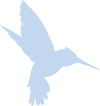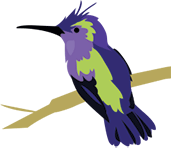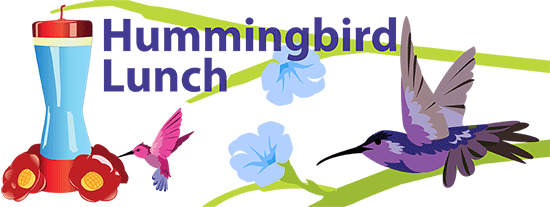Hummingbird Activity: For Teachers
In this experiment the students will make observations of hummingbirds using hummingbird feeders. Students will come up with questions that they generate from their observations. Students will then test if the color of the feeder has any effect on the hummingbirds that utilize these feeders.
Data collection will only require a few minutes each day over the course of a few weeks. Students should then work together in small groups to gather their evidence, look for trends, and prepare to communicate their results in a report formatted as a newspaper article, online blog, or a scientific paper.
It is recommended that students have some knowledge of the scientific method and experiments in science.
Tips for Classroom Implementation
Classroom set-up: The majority of observations are done outside (aside from watching a video before beginning). A little classroom space is required for the initial set up.
Tips: This can be set up as a full inquiry model where the teacher guides student thinking or as a directed inquiry where the teacher supplies the necessary information. Be sure to pay attention to the suggestion for additional controls in step 7.
Extensions: A variety of extensions can be used with this experiment. A teacher could look at adaptations of hummingbirds or the theory of co-evolution regarding the shape of the beaks and the shape of flowers. Students could also do additional research to find answers to the questions they asked at the beginning of the experiment.
Objectives
- Students will investigate whether hummingbirds are more attracted to red feeders than to white feeders.
- Students will collect and compare data based on observations.
- Students will interpret data and form conclusions.
Teaching R.A.F.T.
The writing piece of this experiment includes a RAFT assignment. This stands for Role, Audience, Format and Topic. RAFT helps develop students as more skilled writers and communicators of ideas. Both teacher and student alike can pick an audience to write for, a role, a format and topic.
 In this case the topic would be hummingbirds and the feeder experiment. The students could chose to present their findings in a newspaper article and write for a larger public audience or they could write a formal scientific paper. Both ways would allow the students to communicate their main ideas from the experiment and their takeaways but allow students more freedom of expression.
In this case the topic would be hummingbirds and the feeder experiment. The students could chose to present their findings in a newspaper article and write for a larger public audience or they could write a formal scientific paper. Both ways would allow the students to communicate their main ideas from the experiment and their takeaways but allow students more freedom of expression.
Teachers could also choose to assign the R.A.F.T for a specific purpose. Asking students to write in a more academic tone would require the use of their scientific vocabulary or Tier Three vocabulary terms. See the link below for more information.
Arizona Science Standards:
Strand One: Inquiry Process
Concept 1: Observations, Questions, Hypotheses
- K-4 Observe, ask questions, and make predictions

- 5-8 Formulate predictions, questions, or hypotheses based on observations. Locate appropriate resources
Concept 2: Scientific Testing (investigating and modeling)
- K-4 Participate in planning, and conducting investigations, and recording data
- 5-8 Design and conduct controlled investigations
Concept 3: Analysis and Conclusions
- K-4 Organize and analyze data; compare to predictions
- 5-8 Analyze and interpret data to explain correlations and results; formulate new questions
Concept 4: Communication
- K-4 Communicate results of investigations
- 5-8 Communicate results of investigations
Common Core Standards:
6‐8.RST.3 Follow precisely a multistep procedure when carrying out experiments, taking measurements, or performing technical tasks
6‐8.WHST.2 Write informative/explanatory texts, including the narration of historical events, scientific procedures/experiments, or technical processes
Next Generation Science Standards:
MS-LS2-2 Construct an explanation that predicts patterns of interactions among organisms across multiple ecosystems
Amanda Sibley is a recent graduate of Arizona State University.
Read more about: Hummingbird Lunch
Bibliographic details:
- Article: Hummingbird Activity For Teachers
- Author(s): Dr. Biology
- Publisher: Arizona State University School of Life Sciences Ask A Biologist
- Site name: ASU - Ask A Biologist
- Date published:
- Date accessed:
- Link: https://askabiologist.asu.edu/activities/experiments/hummingbird-feeder/for-teachers
APA Style
Dr. Biology. (). Hummingbird Activity For Teachers. ASU - Ask A Biologist. Retrieved from https://askabiologist.asu.edu/activities/experiments/hummingbird-feeder/for-teachers
Chicago Manual of Style
Dr. Biology. "Hummingbird Activity For Teachers". ASU - Ask A Biologist. . https://askabiologist.asu.edu/activities/experiments/hummingbird-feeder/for-teachers
Dr. Biology. "Hummingbird Activity For Teachers". ASU - Ask A Biologist. . ASU - Ask A Biologist, Web. https://askabiologist.asu.edu/activities/experiments/hummingbird-feeder/for-teachers
MLA 2017 Style

This activity has a companion article Hummingbirds that talks about hummingbird ecology.
Be Part of
Ask A Biologist
By volunteering, or simply sending us feedback on the site. Scientists, teachers, writers, illustrators, and translators are all important to the program. If you are interested in helping with the website we have a Volunteers page to get the process started.


